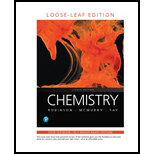
Which element has more nonmetallic character:Cl or Sb?
Interpretation:
The element which is more non-metallic from Cl and Sb is to be determined.
Concept introduction:
The non-metallic character of a given element can be defined as its tendency to accept electrons during a given chemical reaction.
Answer to Problem 22.1P
Cl will be more non-metallic in nature as compared to Sb.
Explanation of Solution
The non-metallic character of a given element is related to its tendency to accept electrons.
The electron affinity of a given atom can be defined as the amount of energy which is released when an electron is added to an atom in neutral state and is present in its gaseous form.
The electron affinity is said to increase as one moves from left to right across the period due to decrease in the atomic radius while the electron affinity decreases as one moves down the group due to increase in the atomic radius.
Chlorine is present in the 3rd period and 17th group of the periodic table while antimony belongs to the 5th period and the 15th group of the modern periodic table.
Therefore, the electron affinity of chlorine will be more than that of Antimony. Hence, the tendency to accept electrons will be more in case of chlorine than antimony. Thus, chlorine is more non-metallic in nature than antimony.
The electron affinity of a given atom can be defined as the amount of energy which is released when an electron is added to an atom in neutral state and is present in its gaseous form.
Want to see more full solutions like this?
Chapter 22 Solutions
Chemistry, Loose-leaf Edition (8th Edition)
- Don't use ai to answer I will report you answerarrow_forwardConsider a solution of 0.00304 moles of 4-nitrobenzoic acid (pKa = 3.442) dissolved in 25 mL water and titrated with 0.0991 M NaOH. Calculate the pH at the equivalence pointarrow_forwardWhat is the name of the following compound? SiMe3arrow_forward
- K Draw the starting structure that would lead to the major product shown under the provided conditions. Drawing 1. NaNH2 2. PhCH2Br 4 57°F Sunny Q Searcharrow_forward7 Draw the starting alkyl bromide that would produce this alkyne under these conditions. F Drawing 1. NaNH2, A 2. H3O+ £ 4 Temps to rise Tomorrow Q Search H2arrow_forward7 Comment on the general features of the predicted (extremely simplified) ¹H- NMR spectrum of lycopene that is provided below. 00 6 57 PPM 3 2 1 0arrow_forward
 Chemistry: The Molecular ScienceChemistryISBN:9781285199047Author:John W. Moore, Conrad L. StanitskiPublisher:Cengage Learning
Chemistry: The Molecular ScienceChemistryISBN:9781285199047Author:John W. Moore, Conrad L. StanitskiPublisher:Cengage Learning Introductory Chemistry: A FoundationChemistryISBN:9781337399425Author:Steven S. Zumdahl, Donald J. DeCostePublisher:Cengage Learning
Introductory Chemistry: A FoundationChemistryISBN:9781337399425Author:Steven S. Zumdahl, Donald J. DeCostePublisher:Cengage Learning General, Organic, and Biological ChemistryChemistryISBN:9781285853918Author:H. Stephen StokerPublisher:Cengage Learning
General, Organic, and Biological ChemistryChemistryISBN:9781285853918Author:H. Stephen StokerPublisher:Cengage Learning Chemistry for Engineering StudentsChemistryISBN:9781337398909Author:Lawrence S. Brown, Tom HolmePublisher:Cengage Learning
Chemistry for Engineering StudentsChemistryISBN:9781337398909Author:Lawrence S. Brown, Tom HolmePublisher:Cengage Learning Chemistry for Today: General, Organic, and Bioche...ChemistryISBN:9781305960060Author:Spencer L. Seager, Michael R. Slabaugh, Maren S. HansenPublisher:Cengage Learning
Chemistry for Today: General, Organic, and Bioche...ChemistryISBN:9781305960060Author:Spencer L. Seager, Michael R. Slabaugh, Maren S. HansenPublisher:Cengage Learning





